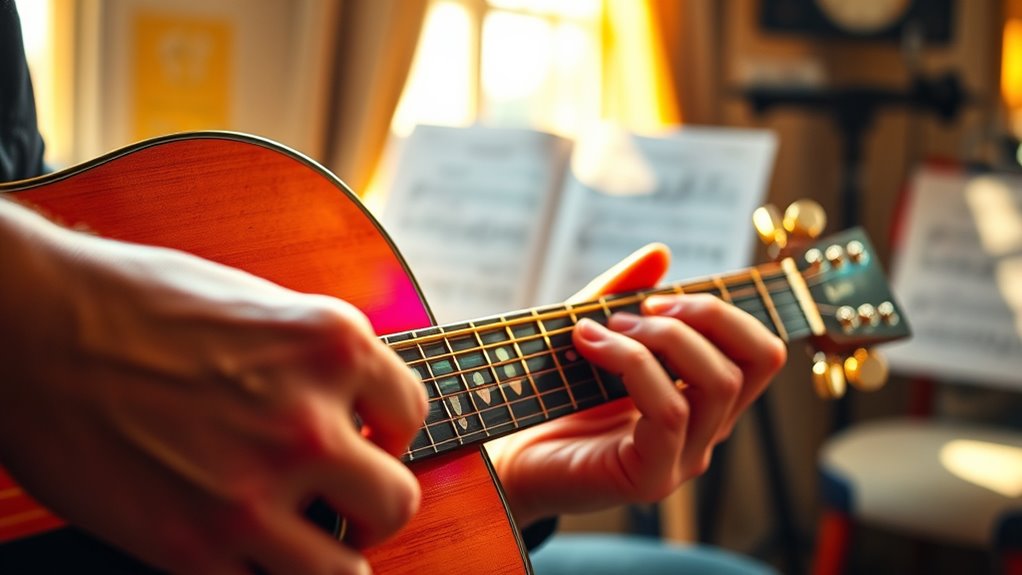Chord substitutions help you refresh familiar progressions by adding variety and emotional depth. Techniques like modal interchange and tritone substitutions allow you to create surprising, colorful harmonic shifts that keep your music engaging. By experimenting with these methods, you can craft more expressive and sophisticated sounds that captivate your listeners. Keep exploring these approaches, and you’ll discover how small changes can open new creative possibilities in your music.
Key Takeaways
- Chord substitutions introduce new harmonic colors, making familiar progressions sound fresh and engaging.
- Modal interchange borrows chords from parallel modes to add emotional depth and variety.
- Tritone substitutions replace dominant chords with others a tritone away, creating surprise and jazzier flavors.
- Combining substitution techniques expands harmonic vocabulary, enabling more expressive and sophisticated progressions.
- Thoughtful use of substitutions maintains musical coherence while adding emotional complexity and interest.

Chord substitutions are a powerful tool for musicians looking to add variety and interest to their progressions. When you understand how to incorporate techniques like modal interchange and tritone substitutions, you can transform simple progressions into dynamic, expressive statements. These methods allow you to step outside the familiar chords and explore new tonal colors, keeping your music fresh and engaging.
Modal interchange is one of the most versatile substitution techniques. It involves borrowing chords from parallel modes or keys to introduce color and emotional depth. For example, if you’re playing in a major key like C Major, you might borrow a chord from its parallel minor, such as borrowing an A♭ major instead of an A minor. This creates a surprising, rich sound that adds emotional complexity without straying too far from the original key. You can also swap out a typical IV chord with a iv chord from the parallel minor, giving your progression a darker or more introspective feel. Modal interchange works best when used sparingly, as it can add a sense of surprise and sophistication without confusing your listener.
Tritone substitutions are another powerful way to refresh your chord progressions. This technique involves replacing a dominant chord with another dominant chord a tritone away. For example, instead of playing a G7 to resolve to C, you might substitute a D♭7. Since these chords share a common tritone interval, the substitution maintains the tension needed for resolution but offers a distinct, jazzier flavor. Tritone substitutions are especially effective in jazz and blues progressions, where creating smooth, unexpected voice leading is key. They help you avoid predictable patterns, making your harmony sound more sophisticated and colorful. When you master tritone substitutions, you’ll find yourself able to craft more complex, compelling progressions that still feel natural to your ear.
Both modal interchange and tritone substitutions expand your harmonic vocabulary, giving you more options to shape your sound. As you experiment, you’ll discover how these techniques can be combined or adapted to suit different styles and moods. Understanding the role of harmonic context can help you determine the most effective way to incorporate these substitutions into your progressions. Keep in mind that subtlety is often more effective than overuse—use these substitutions thoughtfully to enhance your progressions without overwhelming them. By integrating modal interchange and tritone substitutions into your playing, you’ll breathe new life into familiar progressions, making your music more expressive and enthralling.
Frequently Asked Questions
How Do Chord Substitutions Affect Song Mood and Emotion?
Chord substitutions considerably influence your song’s mood and emotion by altering emotional impact and creating musical tension. When you swap chords, you can evoke feelings of surprise, longing, or resolution, depending on the substitution. This technique engages listeners on a deeper level, making your music more dynamic and expressive. By thoughtfully choosing substitutions, you control the emotional flow, adding complexity and interest to your progression.
Can Beginners Effectively Use Chord Substitutions in Their Playing?
Using chord substitutions is like adding a splash of color to a simple painting, and yes, beginners can definitely try them. Start with basic techniques, replacing familiar chords with simple alternatives to add interest. It’s an effective way to learn harmony and make your playing more expressive without overwhelming yourself. With patience, you’ll discover how substitutions can transform your songs, making them more engaging and emotionally rich.
Are There Common Mistakes to Avoid With Chord Substitutions?
Yes, you should avoid mistaken substitutions that disrupt the song’s flow or create dissonance. Be careful not to use overly complex voicings that clutter your playing or confuse listeners. Instead, focus on simple, harmonious substitutions that enhance the progression. Practice listening critically to identify what sounds right, and don’t rush into complicated chords until you’re confident with basic ones. This way, your substitutions add musical interest without causing mistakes.
How Do Jazz and Pop Differ in Their Use of Substitutions?
Like jazz’s smoky clubs of the 1920s, jazz uses more complex harmony and inventive improvisation techniques, making substitutions feel spontaneous and rich. Pop, on the other hand, favors simpler, more predictable progressions with subtle substitutions to maintain catchiness. You often see jazz artists experiment freely, while pop keeps substitutions straightforward for broad appeal. Embrace this difference to add depth or accessibility, depending on your musical goals.
What Software Tools Assist With Experimenting on Chord Substitutions?
You can explore chord substitutions with software tools like iReal Pro, Band-in-a-Box, or Logic Pro. These programs offer interactive analysis and chord progression visualization, making it easy to experiment. They let you modify progressions in real-time, hear how substitutions sound, and learn musical relationships visually. By using these tools, you’ll enhance your understanding and creativity, making your compositions more dynamic and invigorating.
Conclusion
By experimenting with chord substitutions, you breathe new life into familiar progressions. You surprise your ears, spark your creativity, and deepen your musical expression. You break free from routine, embrace innovation, and discover fresh emotional depths. You transform simple chords into mesmerizing stories, turning the predictable into the unexpected. Ultimately, you elevate your playing, ignite your passion, and inspire your audience—because with every substitution, you’re making music that truly moves.









